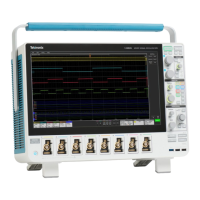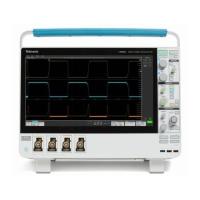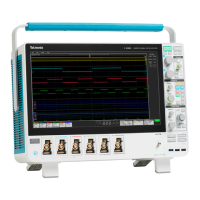Commands listed in alphabetical order
this command sp
ecifies the lower limit of the range. (Use the command
TRIGger:{A|B}:BUS:B<x>:ETHERnet:DATa:HIVALue to set the upper limit of
the range.) The default is all X’s (don’t care). The bus number is specified by <x>.
Conditions
Requires the SR-ENET Triggering and Analysis application.
Group
Trigger
Syntax
TRIGger:{A|B}:BUS:B<x>:ETH ERnet:DATa:VALue <QString >
TRIGger:{A|B}:BUS:B<x>:ETH ERnet:DATa:VALue?
Related Commands
TRIGger:{A|B}:BUS:B<x>:ETHERnet:CONDition
TRIGger:{A|B}:BUS:B<x>:ETHERnet:DATa:OFFSet
TRIGger:{A|B}:BUS:B<x>:ETHERnet:DATa:SIZe
TRIGger:{A|B}:BUS:B<x>:ETHERnet:DATa:HIVALue
Arguments
QString is a quoted string where the allowable characters are 0, 1, and X.
The allowable number of characters depends on the setting for size (using
TRIGger:A:BUS:B<x>:ETHERnet:DATa:SIZe). The bits specified in the
quoted string replace the least s
ignificant bits, leaving any unspecified upper
bits unchanged.
Examples
TRIGger:A:BUS:B1:ETHERnet: DATa:VALue "0
0001000"
sets the binary
data to trigger on to 00001000, assuming the qualifier is set to
LESSthan,
MOREthan, EQual, UN EQual, LESSEQual
or MOREEQual , and DATa:SI Ze
is set to 1 byte.
TRIGger:A:BUS:B1:ETHERnet: DATa:VALue "00001000" sets the lower
limit of the range to 00001000, assuming the qualifier is set to
INrange or
OUTrange,andDATa:SIZe is set to 1 byte.
TRIGger:{A|B}:BUS:B<x>:ETHERnet:IPHeader:DESTinationaddr:VALue
When the Ethernet trigger condition is
set to
IPHeader, this command specifies
the value of the 32–bit destination address that is to be used in the trigger (along
with the source address and protocol value). The IP destination address is a
standard IP address such as 192.168.0.1. The default is all X’s (don’t care). The
bus number is specified by <x>.
Conditions
Requires the SR-ENET Triggering and Analysis application.
MSO54, MSO56, MSO58, MSO58LP Programmer 2-783

